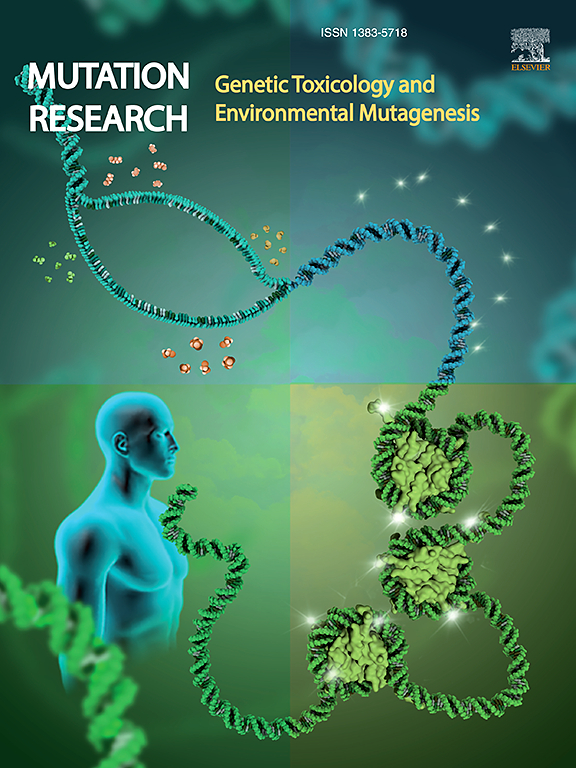Low dose X-radiation induced DNA damage and its association with Glandular dose in women undergoing mammography
IF 2.5
4区 医学
Q3 BIOTECHNOLOGY & APPLIED MICROBIOLOGY
Mutation research. Genetic toxicology and environmental mutagenesis
Pub Date : 2025-02-01
DOI:10.1016/j.mrgentox.2025.503856
引用次数: 0
Abstract
Mammography is a widespread X-ray-based tool used for screening as well as early diagnosis of certain diseases related to breast tissue. However, the use of X-rays in mammography raised concern as a series of low-dose radiation exposures received during this procedure might increase health risks similar to high doses of acute exposure. To understand the effects of low-dose X-irradiation, blood samples were drawn from healthy volunteers (n = 5), X-irradiated in vitro with a dose similar to that obtained during mammography (2.5–3 mGy/plane), and also from women undergoing digital breast tomosynthesis imaging (before and after 1–2 h) (n = 18) were used as models. The level of induced DNA damage was determined using γ-H2AX foci and micronucleus (MN) formation in blood lymphocytes. In the in vitro irradiated samples, the mean γ-H2AX foci frequency in unirradiated control was 0.12 ± 0.03, and in irradiated samples was 0.25 ± 0.02 (p < 0.0001). A similar increase in mean γ-H2AX foci frequency of 0.13 ± 0.01 and 0.21 ± 0.05 was observed before and after mammography imaging respectively (p < 0.0001). A similar trend was observed for in vitro MN where the frequency was 0.0008 ± 0.0008 in unirradiated control and 0.0046 ± 0.0018 in irradiated samples (p < 0.01). Whereas, a heterogeneous increase in MN frequency was observed in women who underwent mammography (p < 0.001). Pearson correlation revealed a strong correlation between Average Glandular Dose (AGD) and γ-H2AX frequency (r2=0.7820) and a weak correlation between AGD and MN frequency (r2=0.0008). The present study suggests that the low doses of radiation from mammography imaging have the potential to induce early DNA damage and residual DNA damage observed until 72 h post-exposure; it might result in an increased risk for stochastic health effects during their lifetime.
接受乳房x光检查的妇女低剂量x射线引起的DNA损伤及其与腺体剂量的关系
乳房x光摄影是一种广泛使用的基于x光的工具,用于筛查和早期诊断与乳腺组织有关的某些疾病。然而,在乳房x光检查中使用x射线引起了关注,因为在此过程中接受的一系列低剂量辐射暴露可能增加与高剂量急性暴露相似的健康风险。为了了解低剂量x射线照射的影响,健康志愿者的血液样本(n = 5),体外x射线照射剂量与乳房x光检查(2.5-3 mGy/平面)相似,以及接受数字乳房断层合成成像(1-2小时前后)的妇女的血液样本(n = 18)被用作模型。采用γ-H2AX聚焦法和血淋巴细胞微核(MN)形成法测定DNA损伤水平。在体外辐照样品中,未辐照对照的γ-H2AX平均焦频率为0.12 ± 0.03,辐照样品的平均焦频率为0.25 ± 0.02 (p <; 0.0001)。乳腺x线造影前后γ-H2AX平均聚焦频率分别升高0.13 ± 0.01和0.21 ± 0.05 (p <; 0.0001)。在体外MN中也观察到类似的趋势,未辐照对照组的频率为0.0008 ± 0.0008,辐照样品的频率为0.0046 ± 0.0018 (p <; 0.01)。然而,在接受乳房x光检查的女性中,观察到MN频率的异质性增加(p <; 0.001)。Pearson相关分析显示,平均腺剂量(AGD)与γ-H2AX频率相关性强(r2=0.7820),与MN频率相关性弱(r2=0.0008)。目前的研究表明,乳房x线摄影成像的低剂量辐射有可能诱发早期DNA损伤和暴露后72 h观察到的残留DNA损伤;这可能会导致他们一生中受到随机健康影响的风险增加。
本文章由计算机程序翻译,如有差异,请以英文原文为准。
求助全文
约1分钟内获得全文
求助全文
来源期刊
CiteScore
3.80
自引率
5.30%
发文量
84
审稿时长
105 days
期刊介绍:
Mutation Research - Genetic Toxicology and Environmental Mutagenesis (MRGTEM) publishes papers advancing knowledge in the field of genetic toxicology. Papers are welcomed in the following areas:
New developments in genotoxicity testing of chemical agents (e.g. improvements in methodology of assay systems and interpretation of results).
Alternatives to and refinement of the use of animals in genotoxicity testing.
Nano-genotoxicology, the study of genotoxicity hazards and risks related to novel man-made nanomaterials.
Studies of epigenetic changes in relation to genotoxic effects.
The use of structure-activity relationships in predicting genotoxic effects.
The isolation and chemical characterization of novel environmental mutagens.
The measurement of genotoxic effects in human populations, when accompanied by quantitative measurements of environmental or occupational exposures.
The application of novel technologies for assessing the hazard and risks associated with genotoxic substances (e.g. OMICS or other high-throughput approaches to genotoxicity testing).
MRGTEM is now accepting submissions for a new section of the journal: Current Topics in Genotoxicity Testing, that will be dedicated to the discussion of current issues relating to design, interpretation and strategic use of genotoxicity tests. This section is envisaged to include discussions relating to the development of new international testing guidelines, but also to wider topics in the field. The evaluation of contrasting or opposing viewpoints is welcomed as long as the presentation is in accordance with the journal''s aims, scope, and policies.

 求助内容:
求助内容: 应助结果提醒方式:
应助结果提醒方式:


